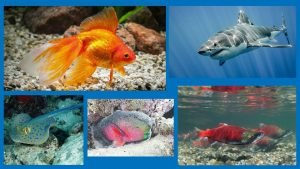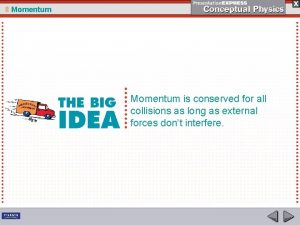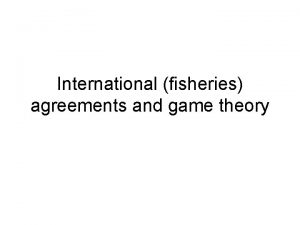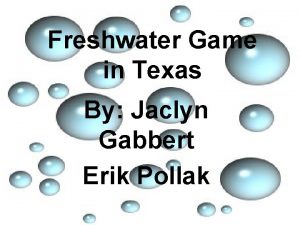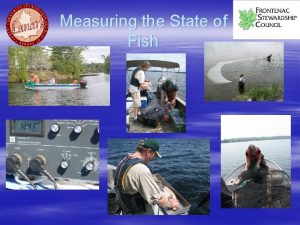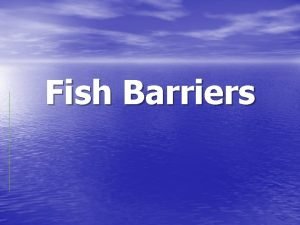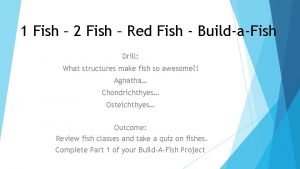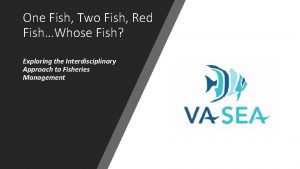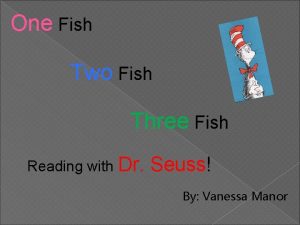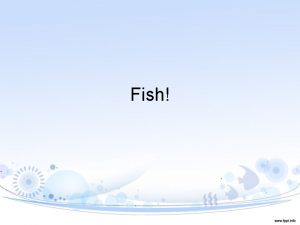Measuring the State of Fish Measuring the State










![Measuring the State of Fish: Creel [Fishing] Surveys § Provides: – estimates of fishing Measuring the State of Fish: Creel [Fishing] Surveys § Provides: – estimates of fishing](https://slidetodoc.com/presentation_image/590f1df0e375df5277d3f2633e0b74e1/image-11.jpg)
![Measuring the State of Fish: Creel [Fishing] Surveys § 4 main types of creel Measuring the State of Fish: Creel [Fishing] Surveys § 4 main types of creel](https://slidetodoc.com/presentation_image/590f1df0e375df5277d3f2633e0b74e1/image-12.jpg)
![Measuring the State of Fish: Creel [Fishing] Surveys § Creel design: – Final estimates Measuring the State of Fish: Creel [Fishing] Surveys § Creel design: – Final estimates](https://slidetodoc.com/presentation_image/590f1df0e375df5277d3f2633e0b74e1/image-13.jpg)
![Measuring the State of Fish: Creel [Fish] Surveys How to conduct a roving creel Measuring the State of Fish: Creel [Fish] Surveys How to conduct a roving creel](https://slidetodoc.com/presentation_image/590f1df0e375df5277d3f2633e0b74e1/image-14.jpg)




- Slides: 18

Measuring the State of Fish

Measuring the State of Fish § There are many human stressors that impact a fish community and specific fish species such as: fishing, habitat loss, invasive species (exotic & range extensions), pollution § MNR utilizes standard netting surveys to measure fish status and some invasive species

Measuring the State of Fish § Other surveys are carried out to measure the stressors such as: – Creel surveys to measure fishing pressure – Water testing to measure pollution, chemical habitat availability (O 2, temp, N, P etc. ) and invasive species – Physical habitat mapping to identify spawning & nursery limitations/opportunities

Measuring the State of Fish: Standard Netting Surveys § benefits – A means of controlling some variables in nature and hopefully measuring them – Reduce sampling bias – Can directly compare results year to year and across different lakes measured using the same standard technique § Standard criteria – – – – Gear size, material, dimensions, configuration Timing (water temperature, thermal stratification) Number of sets per lake and set duration Random selection of sites meeting standard criteria Net orientation to shore and/or depth contours Gear depth Minimum net separation distances and duration between reuse of sites

Measuring the State of Fish: Standard Netting Surveys § There are two main types of gear utilized in lakes – Gill nets – Trap nets

Measuring the State of Fish: Other standard & non-standard gear § Standard electrofishing protocol developed for streams § Other non-standard gear that are useful in certain situations include: seine nets, hoop nets, minnow traps, dip nets, electrofishing boats

Measuring the State of Fish: Pros & Cons of Gill Nets vs Trap Nets Gear Type Gill Nets Cons §Can be lethal if set too long, some surveys utilize shorter set durations to minimize this §Some species not as vulnerable to gill nets (crappie, largemouth bass, sunfish, eel) Pros § can gather more information from lethal sample: better age structures, sexual maturity, contaminant samples, stomach samples §Samples the entire lake §Easier & lighter to handle, can utilize wider variety of boats §Less time required to complete survey, usually can lift, sample and reset 10 -12 nets per day

Measuring the State of Fish: Pros & Cons of Gill Nets vs Trap Nets Gear Type Cons Trap Nets § heavy (dry weight 165 lbs) and harder to handle § boats need to be open at front and minimum 16 ft § more time required to complete survey, usually can only lift, sample and reset four nets per day § lake size, near shore slope & aquatic vegetation can limit # of suitable netting sites § fish smaller than 4” can pass through mesh (perch) Pros § non-lethal sampling §Captures all fish species inhabiting the near shore area

Measuring the State of Fish: Standard Netting Surveys Trap Nets Survey Name Targeted Fish Timing Min. # net sets End of Spring Trap Netting (ESTN) Walleye Spring (May. June) Water 12 C-18 C 16 overnight sets 10 days on lake Nearshore Community Index Netting (NSCIN) All near shore species such as bass, pike, sunfish, crappie, bullheads, suckers, walleye August to end September Water > 13 C 16 overnight sets 10 days on lake

Measuring the State of Fish: Standard Netting Surveys Gill Nets Survey Name Targeted Fish Timing Min # net sets Broad scale All fish species Monitoring (Bs. M) Mid June to end of September Water >18 C 12 -55 overnight sets, lake size & depth dependant 3 -10 days on lake Fall Walleye Index Netting (FWIN) Walleye, yellow perch, cisco, whitefish Late September to late October Water 15 C-10 C 8 -28 overnight sets for lakes 10 to 5000 ha 3 -6 days on lake Summer Profundal Index Netting (SPIN) Lake trout, whitefish, cisco Mid July to mid September 25 -44 two hour sets for lakes 101000 ha 4 -7 days on lake
![Measuring the State of Fish Creel Fishing Surveys Provides estimates of fishing Measuring the State of Fish: Creel [Fishing] Surveys § Provides: – estimates of fishing](https://slidetodoc.com/presentation_image/590f1df0e375df5277d3f2633e0b74e1/image-11.jpg)
Measuring the State of Fish: Creel [Fishing] Surveys § Provides: – estimates of fishing effort, catch rates & total harvest by species – Angler origins & visitor types (daytrip, cottage, paid guest, non-pd guest etc) – Size, weight, age of harvested fish (if collected) Fish species Walleye Pike Bass Trout Fishing effort Catch rate Total Harvest Anglerhrs No. fish/hr No. fish 6500 3200 8900 2200 0. 75 1. 10 1. 45 0. 15 2000 1300 5500
![Measuring the State of Fish Creel Fishing Surveys 4 main types of creel Measuring the State of Fish: Creel [Fishing] Surveys § 4 main types of creel](https://slidetodoc.com/presentation_image/590f1df0e375df5277d3f2633e0b74e1/image-12.jpg)
Measuring the State of Fish: Creel [Fishing] Surveys § 4 main types of creel surveys: – Roving § on the lake counting boats and talking to them § Good for lakes where boats heading out from numerous locations § Often incomplete fishing trip information, used to estimate a complete trip – Access § § § Interviewing anglers as they leave the lake from access point(s) Good for lakes where boats heading out from few locations Get complete fishing trip information, less estimation required – Voluntary logs § Books or forms handed out ahead of time to anglers § Biased results if all large cross section of anglers don’t participate or only fill out for successful trips § Works best with participation incentives and/or on-lake coordinator – Aerial boat counts § § § Boats counted from aircraft Only gives estimate of fishing effort Cost of aircraft can be prohibitive
![Measuring the State of Fish Creel Fishing Surveys Creel design Final estimates Measuring the State of Fish: Creel [Fishing] Surveys § Creel design: – Final estimates](https://slidetodoc.com/presentation_image/590f1df0e375df5277d3f2633e0b74e1/image-13.jpg)
Measuring the State of Fish: Creel [Fishing] Surveys § Creel design: – Final estimates are derived from “snap-shot” samples obtained throughout a survey period – Survey periods experience fluctuating levels of fishing effort, catch rate, harvest etc. depending upon: § Season: spring open fishing seasons, summer vacation, fall, winter § Day type: weekday vs weekend § Period: morning, midday, evening; walleye lakes experience three periods whereas lake trout & bass lakes one or two § Area or lake basins: for larger lakes to ensure boat counts are completed in 30 -50 minutes – Need “snap-shot” samples on 2 -3 occasions, regardless of weather (rain or shine), for each combination of the above
![Measuring the State of Fish Creel Fish Surveys How to conduct a roving creel Measuring the State of Fish: Creel [Fish] Surveys How to conduct a roving creel](https://slidetodoc.com/presentation_image/590f1df0e375df5277d3f2633e0b74e1/image-14.jpg)
Measuring the State of Fish: Creel [Fish] Surveys How to conduct a roving creel survey On randomly chosen sample day: 1. Boat around the lake [basin] and count boats that are fishing, don’t stop to interview during counts, should complete in 30 -50 minutes 2. Interview as many fishing boats as possible. Introduce yourself & ask if they’d mind answering a few quick questions: 1. 2. 3. 4. 5. 6. What time did you start fishing today? Are you staying on the lake, if so, where? Where do you live? What are you fishing for today? Have you caught anything? (record all species caught, often need to prompt for other species) Have you kept anything? If yes, and you are sampling this boat 1. Do you mind if we take lengths, weights and scales from your fish? Plan to carry out two boat counts and 1 -2 interview periods per sample day

Measuring the State of Fish: SAFETY FIRST! § Volunteer agreement forms cover those listed on the form: – Volunteers do not qualify for workplace safety & insurance benefits – MNR has purchased Accidental Death & Dismemberment Policy on behalf of volunteers – Ontario General Liability Protection Program protects volunteers from suits arising through injury caused to another person or another person’s property while performing duties listed on volunteer agreement form – Volunteers dealing with the public will carry volunteer identification provided by MNR

Measuring the State of Fish: SAFETY FIRST! § The Min. of Labour & Transport Canada require certain safety training & equipment is provided & on board: – Safety kit: Cell phone kept in waterproof container, buoyant throw rope (15 m+), working flashlight, flares, fire extinguisher, whistle or some other sounding device, bailing bucket, map of lake, running lights if on lake ½ after sunset or before sunrise – Let someone know where you will be and expected time off lake – All boat operators must have a Pleasure Craft Operators Card – One approved personal flotation device per passenger – One paddle or an anchor with 15 m+ cable, rope or chain – Dry land Man-Over-Board training & dry land putting on PFD in water training § Reminder to stay off or get off the lake if thunderstorms are approaching or other weather conditions such as high winds make it unsafe

How Can Stewardship Councils and Other Partners Get Involved ? § There is reimbursement funding available ($500 -$2500) through the Community Fisheries & Wildlife Involvement Fund (CFWIP) to cover: Equipment & supplies § Deadline to apply is February 1 st § Applications and guidelines available from your district office

CFWIP § CFWIP $ cannot be utilized to pay wages (except for heavy equipment operator costs) § Work must be completed by volunteers § Funding provided after submission of receipts for equipment and materials (applicants must be willing to initially cover purchasing costs) § Equipment purchased with CFWIP $’s is OMNR property and may be returned to OMNR upon completion of project § OMNR staff available to meet with stewardship councils to provide project ideas and technical guidance
 One fish two fish red fish blue fish ride
One fish two fish red fish blue fish ride Twofish and blowfish
Twofish and blowfish Interoparous
Interoparous Fish reproduction
Fish reproduction Cartilaginous fish features
Cartilaginous fish features A big fish swims up and swallows a small fish at rest
A big fish swims up and swallows a small fish at rest Fin fish market forms
Fin fish market forms Montana state fish
Montana state fish Fish state
Fish state New york state fish
New york state fish Hình ảnh bộ gõ cơ thể búng tay
Hình ảnh bộ gõ cơ thể búng tay Lp html
Lp html Bổ thể
Bổ thể Tỉ lệ cơ thể trẻ em
Tỉ lệ cơ thể trẻ em Gấu đi như thế nào
Gấu đi như thế nào Tư thế worms-breton
Tư thế worms-breton Alleluia hat len nguoi oi
Alleluia hat len nguoi oi Các môn thể thao bắt đầu bằng tiếng nhảy
Các môn thể thao bắt đầu bằng tiếng nhảy Thế nào là hệ số cao nhất
Thế nào là hệ số cao nhất




